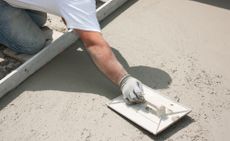What Are Common Causes for Cracking Concrete?

It’s not unusual to see cracks in concrete, but knowing the type of cracking and how to prevent it will keep your property in top shape for longer. Below is a guide to the most common cracks you’ll see in site-mix and ready-mix concrete.
Concrete Cracks & How to Prevent Them
1. Expansion
High temperatures cause concrete to expand, adding stress on a slab. If there is a wall or more concrete nearby, expansion pushes against it, and without flexibility, cracks form against the force. The best way to combat expansion cracking is to ensure joints between inflexible components are filled with compressible material like cellulose fiber or polyfoam, which absorb shock and take the pressure off of the concrete.
2. Plastic Shrinkage
Before it fully hardens, site mix and ready-mix concrete is set in a plastic state, meaning it is filled with water. As it cures, moisture is lost, which leads to shrinkage that can be stressful on the slab. To break the tension as the material hardens, cracks form. When the weather is extremely hot or cold, the lack of moisture in both conditions combined with the intense temperatures speeds up the shrinkage, while moderate temperatures and a balanced mix ensure a proper installation.
3. Settling
 When voids are created nearby, either from decomposing or removed tree roots or trenches from utility and plumbing lines, the concrete on top can crack. Concrete near homes with basements or crawlspaces may also see this issue, mainly because the backfill for the foundation wasn’t compacted. The empty space that occurs when these items are moved, shifted, or settled eliminates the support needed to keep concrete intact, but digging out and properly compacting the ground before pouring will help.
When voids are created nearby, either from decomposing or removed tree roots or trenches from utility and plumbing lines, the concrete on top can crack. Concrete near homes with basements or crawlspaces may also see this issue, mainly because the backfill for the foundation wasn’t compacted. The empty space that occurs when these items are moved, shifted, or settled eliminates the support needed to keep concrete intact, but digging out and properly compacting the ground before pouring will help.
4. Heaving
Frozen ground will lift and then settle back down when it thaws, leading to heaving cracks as the slab moves. Large tree roots will also produce a heaving effect when they are too close to concrete, lifting and shifting each area until cracks form. Adding insulation underneath can regulate temperatures and prevent roots from penetrating the area.
5. Premature Drying
You may notice web-like cracking on the surface, which usually occurs when the slab dries too quickly. These fine imperfections happen when there is too much sun or wind removing moisture from the top before the bottom dries. Being mindful to not carry out your project during a scolding hot summer day will help, along with patching the surface to repair it.
For ready-mix concrete and quality aggregates in Rochester, NY, contact The Dolomite Group. The wholesale distributor has been the area’s choice in crushed stone, asphalt, and gravel for a century. Projects large and small are covered, and their affordable rates make it easy to stay in budget for your next construction job. To discuss your residential or commercial delivery needs, call (585) 381-7010, or visit them online to learn more about their products.
About the Business
Have a question? Ask the experts!
Send your question

